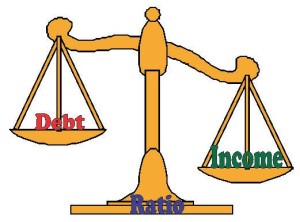Mortgage Loan Programs: Debt to Income Ratios to Know
Many home buyers want to know what are the Debt-To-Income Ratios For The Major Loan Programs? So I  thought it would be good to have my mortgage guest blogger, George Soutu, write a separate post to answer those questions in depth.
thought it would be good to have my mortgage guest blogger, George Soutu, write a separate post to answer those questions in depth.
With the creation of the Consumer Financial Credit Bureau (CFPB), 45% Total Debt-To-Income is pretty much the limit. The exception being the FHA loan program which still allows Total Debt-To-Income ratios of as much as 55% or more. However, two of the major loan programs, FHA & USDA, have two ratios which Borrowers MUST stay under, and staying under the first ratio can be difficult:
- The first ratio is the Housing Ratio, known as the “Front or Top Ratio”
- The second ratio is the Total Debt-To-Income Ratio, known as the “Back or Bottom Ratio”.
NOTE: Debt-To-Income Ratios are figured off of the Borrowers total gross income (before tax income) if the borrower receives W-2 income. The Net Gross Income (after business adjustments) if the borrower is self-employed.
The Debt-To-Income Ratios for the four major loan programs are, as follows:
- Conventional: 45% Total Debt-To-Income. Conventional loans only have one Debt-To-Income Ratio, and it is Total Debt-To-Income also known as the Back or Bottom Ratio.
- FHA: 45/55%+. FHA has two ratios which the Borrower has to stay under. 45% on the Front/Top Ratio, and 55+% on the Back/Bottom Ratio. FHA has by far the most liberal Debt-To-Income Ratios of the major loan programs. However, many Lenders will not go over a 50% Total Debt-To-Income Ratio even though FHA will go much higher.
- USDA: 29/41. USDA also has two Debt-To-Income Ratios like FHA, but they are much tighter. Making USDA a more difficult loan program to qualify for.
- VA: Somewhere between 41% to 45% Total Debt-To-Income Ratio. I say somewhere because the Total Debt-To-Income Ratio will depend on the automated Underwriting Systems. VA requires the Borrower to have residual income (emergency cash so to speak) in order to qualify. Even though theoretically it is possible to get an Approved/Eligible or Accept from the Automated Underwriting Systems, it is unlikely it will give an Approved/Eligible or Accept if the Total Debt-To-Income is much higher than 41%, This is because there will not be enough residual income.
Here are some other mortgage posts written by my guest blogger, George Soutu, to read with valuable information:
How Does Divorce Affect Mortgage Borrowing | Must Knows
Why so Few VA Mortgages Are Obtained by Veterans?
Mortgage Loan Programs: Debt to Income Ratios to Know
~~~~~~~~~~~~~~~~~~~~~~~~
Info about the post author and guest blogger, George Soutu:
George Soutu is a mortgage Loan Officer who can assist you with all your FHA, CHFA, and Conventional mortgage needs in Connecticut. George resides in Middlesex County which includes Middletown, Middlefield, Durham, Cromwell, Portland, Higganum, Haddam, East Haddam, Chester, Deep River, and Essex. George can be contacted at (860) 573-1308 or gsouto@mccuemortgage.com.
I appreciate George’s shares on mortgage information in the current real estate times with my web site readers at www.RIHouseHunt.com
Rhode Island real estate agent and licensed RI real estate agent, Ginny Lacey Gorman, helps list homes and waterfront property in Rhode Island at 401-529-7849 or email me at Ginny@RiHouseHunt.com.



